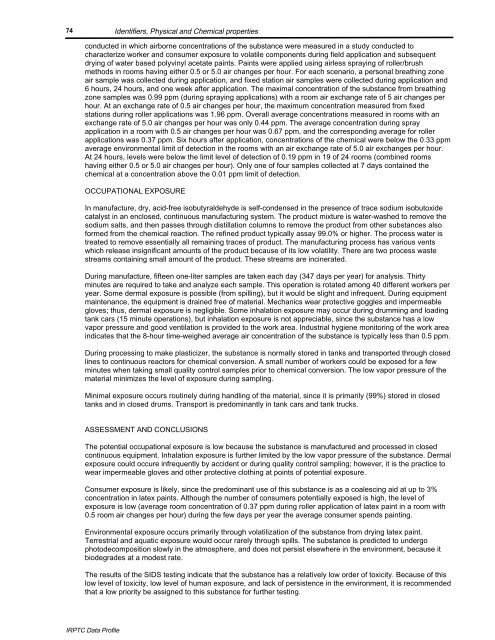TEXANOL CAS N°: 25265-77-4
TEXANOL CAS N°: 25265-77-4
TEXANOL CAS N°: 25265-77-4
You also want an ePaper? Increase the reach of your titles
YUMPU automatically turns print PDFs into web optimized ePapers that Google loves.
74<br />
Identifiers, Physical and Chemical properties<br />
conducted in which airborne concentrations of the substance were measured in a study conducted to<br />
characterize worker and consumer exposure to volatile components during field application and subsequent<br />
drying of water based polyvinyl acetate paints. Paints were applied using airless spraying of roller/brush<br />
methods in rooms having either 0.5 or 5.0 air changes per hour. For each scenario, a personal breathing zone<br />
air sample was collected during application, and fixed station air samples were collected during application and<br />
6 hours, 24 hours, and one week after application. The maximal concentration of the substance from breathing<br />
zone samples was 0.99 ppm (during spraying applications) with a room air exchange rate of 5 air changes per<br />
hour. At an exchange rate of 0.5 air changes per hour, the maximum concentration measured from fixed<br />
stations during roller applications was 1.96 ppm. Overall average concentrations measured in rooms with an<br />
exchange rate of 5.0 air changes per hour was only 0.44 ppm. The average concentration during spray<br />
application in a room with 0.5 air changes per hour was 0.67 ppm, and the corresponding average for roller<br />
applications was 0.37 ppm. Six hours after application, concentrations of the chemical were below the 0.33 ppm<br />
average environmental limit of detection in the rooms with an air exchange rate of 5.0 air exchanges per hour.<br />
At 24 hours, levels were below the limit level of detection of 0.19 ppm in 19 of 24 rooms (combined rooms<br />
having either 0.5 or 5.0 air changes per hour). Only one of four samples collected at 7 days contained the<br />
chemical at a concentration above the 0.01 ppm limit of detection.<br />
OCCUPATIONAL EXPOSURE<br />
In manufacture, dry, acid-free isobutyraldehyde is self-condensed in the presence of trace sodium isobutoxide<br />
catalyst in an enclosed, continuous manufacturing system. The product mixture is water-washed to remove the<br />
sodium salts, and then passes through distillation columns to remove the product from other substances also<br />
formed from the chemical reaction. The refined product typically assay 99.0% or higher. The process water is<br />
treated to remove essentially all remaining traces of product. The manufacturing process has various vents<br />
which release insignificant amounts of the product because of its low volatility. There are two process waste<br />
streams containing small amount of the product. These streams are incinerated.<br />
During manufacture, fifteen one-liter samples are taken each day (347 days per year) for analysis. Thirty<br />
minutes are required to take and analyze each sample. This operation is rotated among 40 different workers per<br />
year. Some dermal exposure is possible (from spilling), but it would be slight and infrequent. During equipment<br />
maintenance, the equipment is drained free of material. Mechanics wear protective goggles and impermeable<br />
gloves; thus, dermal exposure is negligible. Some inhalation exposure may occur during drumming and loading<br />
tank cars (15 minute operations), but inhalation exposure is not appreciable, since the substance has a low<br />
vapor pressure and good ventilation is provided to the work area. Industrial hygiene monitoring of the work area<br />
indicates that the 8-hour time-weighed average air concentration of the substance is typically less than 0.5 ppm.<br />
During processing to make plasticizer, the substance is normally stored in tanks and transported through closed<br />
lines to continuous reactors for chemical conversion. A small number of workers could be exposed for a few<br />
minutes when taking small quality control samples prior to chemical conversion. The low vapor pressure of the<br />
material minimizes the level of exposure during sampling.<br />
Minimal exposure occurs routinely during handling of the material, since it is primarily (99%) stored in closed<br />
tanks and in closed drums. Transport is predominantly in tank cars and tank trucks.<br />
ASSESSMENT AND CONCLUSIONS<br />
The potential occupational exposure is low because the substance is manufactured and processed in closed<br />
continuous equipment. Inhalation exposure is further limited by the low vapor pressure of the substance. Dermal<br />
exposure could occure infrequently by accident or during quality control sampling; however, it is the practice to<br />
wear impermeable gloves and other protective clothing at points of potential exposure.<br />
Consumer exposure is likely, since the predominant use of this substance is as a coalescing aid at up to 3%<br />
concentration in latex paints. Although the number of consumers potentially exposed is high, the level of<br />
exposure is low (average room concentration of 0.37 ppm during roller application of latex paint in a room with<br />
0.5 room air changes per hour) during the few days per year the average consumer spends painting.<br />
Environmental exposure occurs primarily through volatilization of the substance from drying latex paint.<br />
Terrestrial and aquatic exposure would occur rarely through spills. The substance is predicted to undergo<br />
photodecomposition slowly in the atmosphere, and does not persist elsewhere in the environment, because it<br />
biodegrades at a modest rate.<br />
The results of the SIDS testing indicate that the substance has a relatively low order of toxicity. Because of this<br />
low level of toxicity, low level of human exposure, and lack of persistence in the environment, it is recommended<br />
that a low priority be assigned to this substance for further testing.<br />
IRPTC Data Profile
















